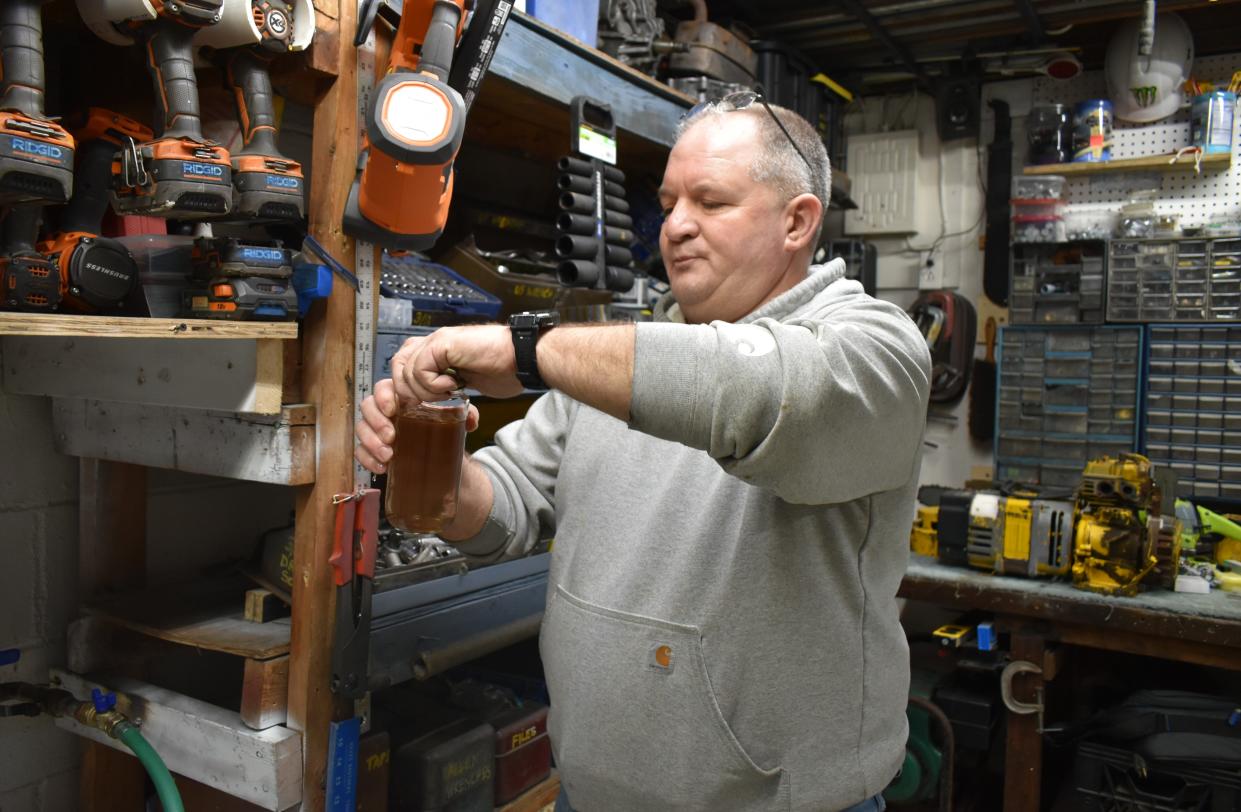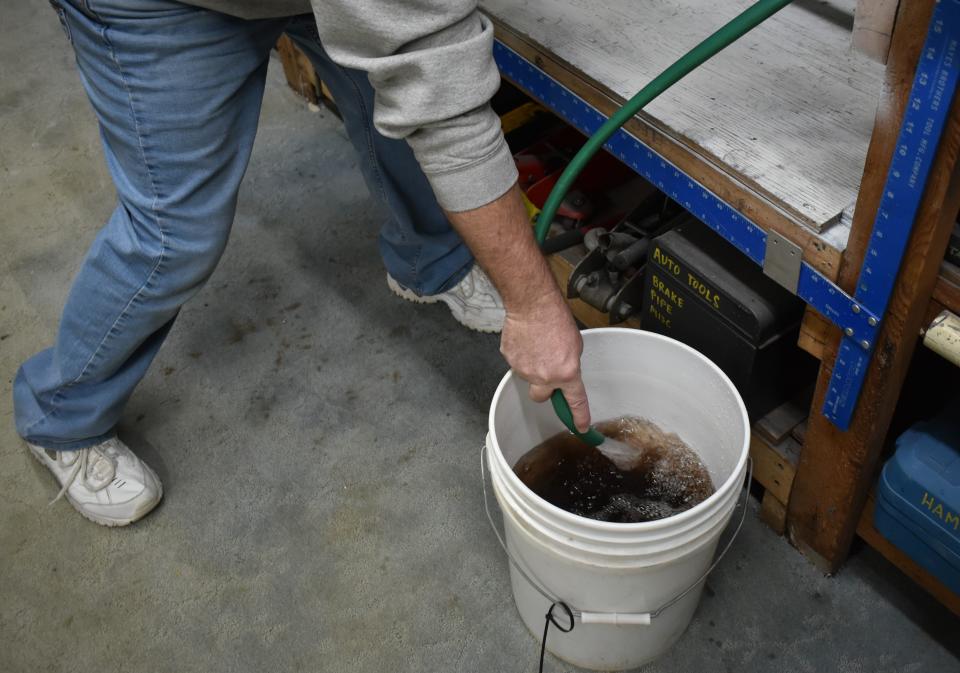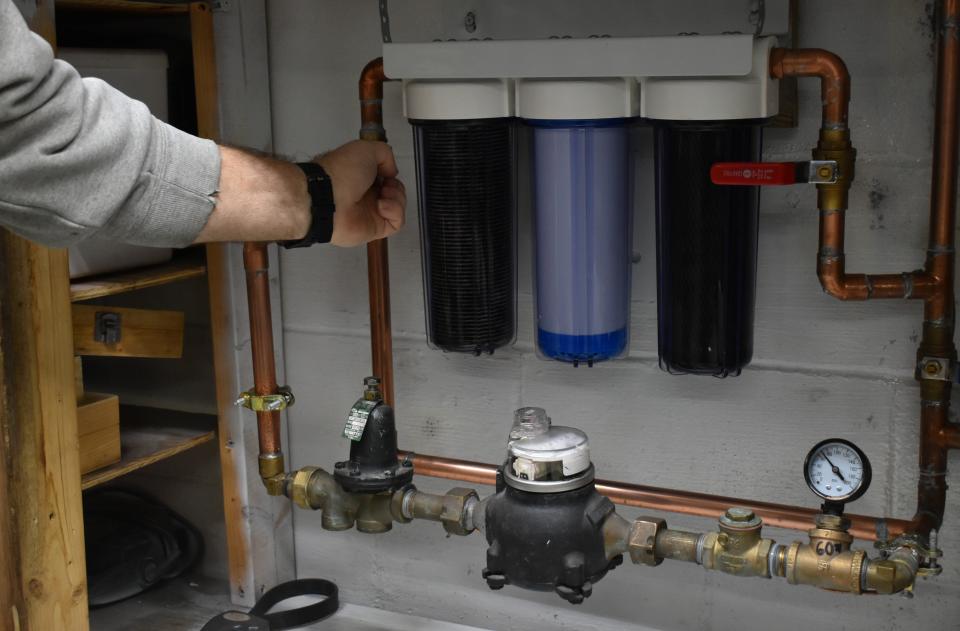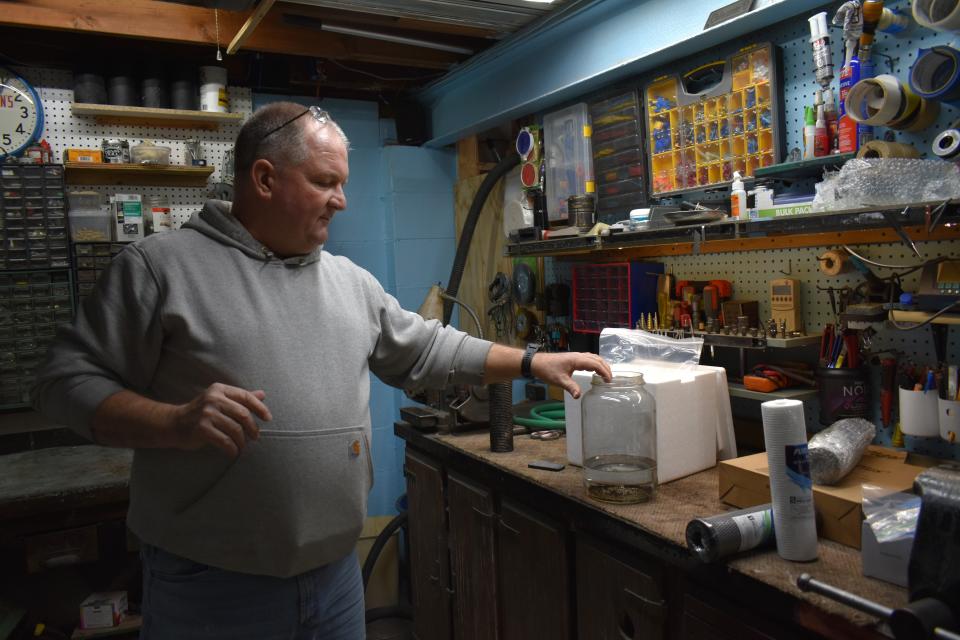Industry residents ‘exhausted’ by months of dirty drinking water

INDUSTRY – David Butts prefers to watch barges float along the Ohio River behind his Riverview Avenue home each morning, eased by the sounds of goldfinches and the steam rising from the nearby power plant.
Those moments of comfort have been hard to come by in recent months, as much of his time is dedicated to water sampling and requesting public information.
“It’s all the time,” he said. “It’s consuming. I’m constantly researching Right-to-Know laws and EPA stuff. It’s not fun.”
The longtime Beaver County resident is one of dozens in Industry demanding to know the source of the coffee-colored, sediment-laced water routinely flowing from their faucets.
It’s been a two-year battle for Butts, but the issue has worsened since last fall. In November 2022, he installed a $500 reverse osmosis water filter system for his mother’s sleep apnea machine and spent hundreds more on a filter system for his entire house. Before installing the filter, his water had stained clothes and damaged multiple washing machines, he said.
Industry resident Jessica Mccafferty won’t drink or cook with her home water, either — noting her boyfriend recently spotted black chunks in his spaghetti. Although her quality issues are intermittent, she buys nursery water for her 10-month-old son and relies on a dispenser at home. Other residents, like Paula Bloor Camp, report extremely low water pressure alongside the dirty water. She said her parents are unable to drink their water due to health concerns. A local business owner is simply "exhausted" by the water quality.
“We don’t even know exactly how many people are having these problems,” said Butts. “And a big sum of Industry is elderly.”
He and his neighbors recently launched a Facebook page to document their water woes. The page has since amassed more than 110 members in a borough of 1,800 people.

After receiving “not a single answer about the water since late October,” Butts submitted nearly a dozen public records requests to the Industry Borough Municipal Authority in December and January. The requested information included recent water sampling results, meeting minutes, maintenance logs, public employee wages and even the municipal building’s “inconsistent” hours of operation.
IBMA staff requested a 30-day extension for nearly all of the records, citing the need for legal review. Staff fulfilled many of the requests in February, with a few exceptions.
November records show a dozen Industry water samples were processed by Campbell Laboratory in New Brighton. Three of the samples appeared to test over the U.S. Environmental Protection Agency’s suggested 0.05 mg/L limit for manganese in drinking water. One sample tested at 1.44 mg/L — nearly 30 times the EPA’s secondary maximum contaminant standard for manganese.
More: Aliquippa water authority breaks ground on multi-million dollar treatment plant
Public water systems are not required to test for “secondary contaminants” like manganese under the federal Safe Drinking Water Act, but the EPA has set non-mandatory water quality standards to help manage what it considers “nuisance contaminants” in drinking water that are not considered a threat to public health in small amounts. These are contaminants that affect the taste, color and/or odor of drinking water. The EPA sets this standard at 0.05 mg/L for manganese to limit staining and metallic-tasting water.
Manganese is a trace mineral that can have cosmetic effects on drinking water at mild levels. It can stain faucets, sinks and even cause skin and tooth discoloration. While considered harmless at low levels, long-term exposure to high levels of manganese in water can be toxic and result in permanent neurological disorders, according to the Centers for Disease Control and Prevention. The EPA’s health advisory for lifetime exposure to manganese in drinking water is 0.3mg/L, based on daily dietary intake not associated with adverse health effects.
At a tense January IBMA meeting, board members acknowledged the dirty water is likely caused by manganese mixing with the chlorine used to treat the water. Staff and board members are working to fix the issues, they said, including plans to clean the borough’s two wells and four steel storage tanks. The IBMA earlier this week sent out a public notice that it will flush water lines from Feb. 12-28, adding that customers may experience low water pressure or discoloration during this time.

“There have been multiple things done to rectify this,” said board member Andy Zachodni at the January meeting. “This is not going to get cleared up overnight. It takes time.”
Board members said the borough has met all mandatory federal and state drinking water quality standards. Industry’s water system was installed in the 1960s, and the water lines are made primarily of ductile cast iron. Unlike other western Pennsylvania municipalities with deteriorating lines from the early 1900s, Industry has “no evidence of lead pipes in our system, and no mass breaks to let us know the system is failing,” board members said.
The IBMA did not respond to requests for additional comment.
Butts and Mccafferty called the IBMA’s efforts a “Band-Aid.”
“If your lines are good, then stuff shouldn't be getting into the system.,” Butts said. “Why not pay for the tools to do diagnostic scoping of the lines and figure out where the problem is?”
Butts plans to do his own extensive trace testing to determine the source of his stained water. He’s sending a sample to Penn State at a cost of $220 plus shipping, he said.
“I can’t afford to do these tests, but they haven’t given me a definitive answer,” he said.

Industry isn’t the only place in Beaver County with persistent water troubles.
The Municipal Water Authority of Aliquippa broke ground on a new $15 million water filtration plant in early 2021, near its decades-old facility, a year after hundreds of residents publicly protested their own brown, pungent water. Customers reported sediment in the water, especially during neighborhood line breaks. The chlorine scent was so strong in one case that a resident reportedly fainted in the shower. Others have blamed the water for their worsening skin conditions.
The cause in many of these cases was iron and manganese mixing with chlorine. Following months of complaints, Pennsylvania’s Department of Environmental Protection ordered the authority to improve its testing for drinking water contaminants. Those tests inadvertently revealed elevated levels of lead in a handful of homes with aging lead pipes.
More: Aliquippa residents face high bills, brown water
Funding for drinking water infrastructure has not kept pace with a growing, critical need to improve aging systems, according to the American Society of Civil Engineers, and that burden typically falls on cash-strapped local and state governments. Decades-old pipes and treatment facilities, alongside stagnant federal funding, have left a number of water utilities struggling to provide quality drinking water.
Municipal water authorities are often understaffed, underfunded and directed by volunteer boards. The IBMA’s five board members are paid $10 a month for their services, and the authority had 10 full- and part-time staff members in 2022, who earned a combined $84,000 that year. The highest single salary was just over $23,000 a year. Still, the IBMA reported a total net position of just over $1 million in 2020.
Train problems: East Palestine evacuation lifted for residents, roads beginning to open around area
Butts is frustrated with the delays he’s faced trying to obtain standard public information, a complaint many Beaver Countians have when seeking guidance from municipalities with limited staffing and hours.
“We just want answers…and clean water,” Butts said.
This article originally appeared on Beaver County Times: Industry, Pa., residents ‘exhausted’ by months of dirty drinking water

